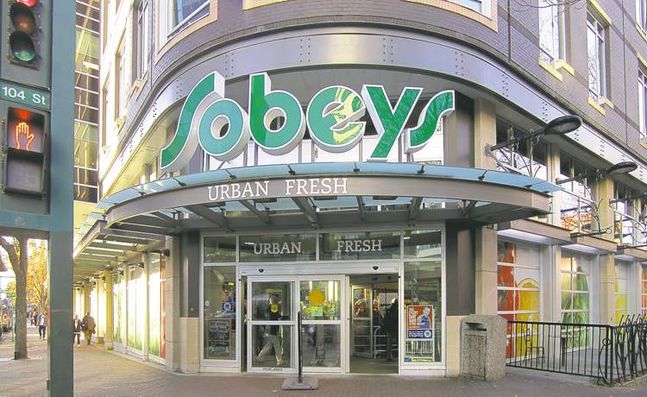
PREGNANT WOMAN: What's that for?
OBSTETRICIAN: That's the machine that goes 'ping.' (Ping) You see? That means your baby is still alive! Its the most expensive machine in the hospital!
If the "machine that goes ping" from the Monty Python film The Meaning of Life, were to be hooked up to Winnipeg's downtown Hudson's Bay department store, the pinging sounds would likely be few and far between. The old store appears to be clinging to life after closing four of its six floors, the Paddlewheel restaurant and most recently its Zellers and basement grocery store.
The loss of downtown's largest supermarket has brought community groups, politicians and business organizations together in search of a replacement food retailer for the city centre.
While it is critical to ensure the Hudson's Bay Co. continues its nearly two-century-long presence in downtown, the closing of its grocer opens an opportunity to reposition that amenity as a targeted catalyst for development in a more strategic location.
As a community, we have successfully invested $40 million in the past few years through the Downtown Residential Development Grant Program in an effort to increase residential density in the core. This will result in the construction of more than 1,500 new units and has already contributed to a downtown population increase of more than 20 per cent over the last five years.
To protect that investment and continue the momentum of growth, it is imperative that we begin to broaden our goals of urban renewal beyond simply adding residential density. Attracting amenities that improve the lifestyle quality of downtown will make urban living more appealing, increase demand and grow market rates to self-sustaining levels. People are attracted to downtown living by the energy and vibrancy that only urban environments can offer. Walkable access to groceries is understood to be a vital contributor to the appeal of this urban lifestyle.
The City of Edmonton began a similar search for a grocer in their downtown a number of years ago, and in 2008 opened a 1,700-square-metre Sobeys Urban Fresh on Jasper Avenue. The small-scale supermarket targeted working professionals, offering local foods, product variety and organic produce. The retailer was positioned at the base of a large highrise residential project that provided an immediate market. The site was located on a busy street near a transit hub, adjacent to the highest office density in the city. All these factors worked together to create the economic conditions that support a successful grocer, helping to make a predominantly commercial area more attractive to residential development. This strategic positioning might be used as a template when establishing the business case for a new downtown supermarket in Winnipeg.
Projects such as the Avenue Building, Centrepoint, So/Po, the Sheraton and Place Louis Riel hotel conversions are adding more than 700 residential units to the area around Portage Avenue. These developments are beginning to fill in the physical gaps and blur the psychological divide between the traditional commercial core of downtown and the dense residential areas of Broadway-Assiniboine to the south. This growth may provide the opportunity for a new grocer to be strategically positioned within this area to motivate further residential development while serving a large percentage of the downtown's 70,000 transient workers and 16,000 permanent residents.
Toronto-based developer Fortress Real Developments Inc. is currently finalizing plans to construct an iconic mixed-use project, rumoured to be worth up to $150 million. To be located near the MTS Centre, the scale of this development, combined with these other projects in the area, may create a tipping point that attracts a supermarket retailer. Built at or near this location, it would follow the Edmonton Sobeys template by anchoring a new large-scale project, serving both the commercial core and the residential areas of downtown, while connecting to the skywalk system and the Graham Avenue Transit Mall.
Hamilton's civic government recently attracted a downtown grocer by offering a $650,000 loan incentive to a qualified proponent. Winnipeg city council has elected not to follow this example and will instead rely on the advocacy of the Downtown BIZ and Community Residents' Association to formulate the business case and overcome the economic preconceptions of downtown Winnipeg in an effort to attract potential food retailers.
The revenues of the Bay grocery were reported to be in the range of $8 million annually. Industry statistics indicate a food store can be profitable with annual revenues of approximately $5,000 per square metre, reflecting an existing market size that would support a 1,600-square-metre facility, similar in scale to Edmonton's Sobeys Urban Fresh.
As retailers experiment with smaller, urban-style supermarket models in other centres, Winnipeg's now-underserved market, augmented by an improved central location and continued momentum in downtown growth might prove to be an attractive economic environment for this model of food retailer.
With strong advocacy and civic leadership, it may be possible to turn the loss of the Hudson's Bay grocery into an opportunity to use food retail as a strategic urban-planning tool that improves the livability of downtown and capitalizes on its potential as a targeted catalyst of economic and residential growth in key areas of Winnipeg's city centre.
Brent Bellamy is senior design architect for Number Ten Architectural Group.
bbellamy@numberten.com
Republished from the Winnipeg Free Press print edition April 8, 2013 B4